Sign In to Your Account
Subscribers have complete access to the archive.
Sign In Not a Subscriber?Join NowTHAT OLD STAR MAGIC
The Archivist
James Quirk edited the first, powerful fan magazine, Photoplay, in the 20s and 30s, introduced Joe Kennedy to Hollywood (and to Gloria Swanson), and hobnobbed with Mary Pickford and Cecil B. DeMille. His nephew, Larry, has made a life—and a cause—from that legacy
PATRICIA BOSWORTH
August 1997. Engulfed by teetering piles of books, moldering magazines, yellowed newspapers, fading movie posters, bulging files, and stacks of dusty publicity stills stuffed into old Lord & Taylor shopping bags, Larry Quirk, the film historian and former fanmagazine editor, is banging out another manuscript on his typewriter. He works in the confines of a tiny, rent-controlled Greenwich Village apartment he’s been living in since 1955, and the place is so crammed with memorabilia that you can barely make out the shape of his battered desk with a black dial telephone on it. Quirk admits that he hasn’t seen the kitchen for at least 10 years.
“My uncle created the formatgossip columns, celebrity profiles, notes on movie productions.”
“Grotesque, isn’t it?” he asks.
In a word, yes. But the fact remains that the 74-year-old author—with white hair in a crew cut and a rosy, compassionate face—has written 30 books in this dim, airless room, and most of them are still in print. They include biographies of Bette Davis, Paul Newman, Warren Beatty, Cher, Joan Crawford, Ronald Colman, and Norma Shearer. He has also ground out hundreds of articles on the movies for The New York Times, Variety, and the Boston Herald. He edits and publishes Quirk’s Reviews, a 12-page monthly journal on film culture which he mails to about 1,000 film buffs and public-relations people at a cost of $1 an issue.
He does all this in an effort to preserve the glorious old Hollywood once documented by his uncle James R. Quirk, the editor of Photoplay magazine during the 1920s and 30s, when movie stars loomed larger than life and the public’s fantasies were reinforced every time they sat in the dark and watched films with Greta Garbo or Clark Gable. Larry Quirk says that he has lived his “strange, sad existence” in order to pay tribute to his uncle, and the only way he can do that is to write about his career, his obsessions, his values. Quirk has mentioned his uncle in most of his books.
My Uncle Jimmy was my role model,” he explains. “Fiercely independent, very Irish. Always on the side of the good and the beautiful. He made up for my father when I was growing up. My father was nothing but a mean drunk.
“My uncle literally created the fanmagazine format,” he continues. “Gossip columns, celebrity profiles, notes on movie productions. He knew America needed heroes, and he saw Hollywood as the dream capital, full of glamour, excitement, and adventure. His version of Photoplay reflected just that. There were gorgeous color covers, wonderful photographs, and articles on everything from how to plot a screenplay to a session behind the scenes with Lillian Gish. He had Robert Sherwood writing movie reviews and Adela Rogers St. Johns— who went on to be Hearst’s top reporter—interviewing the stars. From 1914 to 1932, Photoplay was the most influential film magazine in America. Before the Oscar, the highest cinematic honor an actor could win was Photoplay’s Gold Medal Award. My uncle had started off as John Fitzgerald’s private secretary in Boston when Honey Fitz was mayor, so he became close to all the Kennedys. He convinced Joe Kennedy that the movie industry could turn him an enormous profit; Joe ultimately bought a Keith Albee movie circuit as a result. Uncle Jimmy also introduced him to Gloria Swanson, and that turned out to be one of the legendary affairs of Hollywood. . . . My uncle was close to everybody in the business, from Adolph Zukor to L. B. Mayer, the Selznicks, C. B. DeMille. He knew Chaplin, Garbo, Buster Keaton. He advised Mary Pickford to cut off her curls and take on more mature roles.
“My uncle arranged Rudolph Valentino’s funeral at Campbell’s in New York. He chose the casket. And to save that idol from wear and tear, he substituted a wax dummy for the body—called in an artist who was Skilled at creating a perfect likeness. So while the real Valentino lay in peace in a cool, dark vault, my uncle’s wax figure of Rudy took the brutal punishment from Valentino’s hundreds of fans at the funeral parlor.”
CONTINUED ON PAGE 193
“My uncle chose Valentino’s casket and substituted a wax dummy for the body.”
CONTINUED FROM PAGE 190
Once Quirk starts talking, he can’t stop. He loves to dish, but he hates what he calls today’s emphasis on “junk” news stories, like Hugh Grant and the prostitute in 1995. “The O. J. Simpson tragedy was turned into TV entertainment,” he growls. “I go by my Uncle Jimmy’s credo: A distance should be kept between the star and the public. When I was starting to write for the fan mags in the 1950s, there wasn’t such a close psychic—or should I say psychotic—connection between Joe Schmo and the likes of Madonna.”
In the late 1940s and early 50s, 60 million Americans attended movies every week, and they were hungry to hear stories about their favorite stars—Humphrey Bogart, Ingrid Bergman, Cary Grant. That’s where the fan magazines came in, according to Quirk. “The fan magazines helped to create a kind of fiction. We’d write stories about the stars as ordinary people living in suburban homes with dogs and gardens and barbecue pits. It was a great American fantasy—the stars were as ‘normal’ as we were. Everybody believed Joan Crawford was the loving mother of four adopted kids. Nobody knew until Faye Dunaway starred in Mommie Dearest that Crawford actually beat her kids with clothes hangers. Scandals were hushed up. When Clark Gable ran over a little boy— Gable was drunk—somebody else at MGM took the rap. I was banned from MGM because I wrote about how Doris Day’s husband Marty Melcher was screwing around with her money.
“Today nothing is sacred. Nothing. Do people really want to know about how Marlon Brando farts? Or Whoopi Goldberg’s opinion on the subject? Her new book begins with that word. The furthest I’ve ever gone is to reveal that Cher has a tattoo on her butt.” He lists some of her other tattoos, which include a blue-black orchid above her pubis. “She gets most of them done at an all-female tattoo parlor called Red Devil on LaBrea in L.A.”
Back in 1965, Larry Quirk was my first boss. While he was editor of Screen Stars magazine, he hired me as a writer. We’ve never lost touch. Larry and I were part of a group who worked for a company called Magazine Management. It occupied one lowceilinged floor of dingy offices off East 58th Street, and the space could barely contain all of its publications. Aside from the fan mags (Screen Stars, Movie World, Movie Album), there were a couple of romance magazines and Marvel Comics, created by cartoonist Stan Lee, as well as five men’s magazines, edited by the incredibly handsome novelist Bruce Jay Friedman, who had just published A Mother’s Kisses.
The men’s magazines, featuring fictionalized sex-andaction tales, were the moneymakers— Stag, For Men Only, Male, True Action. Stag and Male each sold a million copies a month. {Screen Stars scraped by at about 60,000.)
The then unknown novelist Mario Puzo was the star writer at True Action. He could concoct the most preposterous tales and make them totally believable. “We needed 50 stories a month to fill our publications,” Bruce told me recently. “It could be a bar-hooker yarn, a death trek to Borneo, a bridge being blown up in Shanghai, and Mario would never fail us. He could whip up a wild combination of characters, dialogue, and action, and nail the story to the wall. Since he was a veteran of World War II, his specialty was creating giant mythical armies in combat in Central Europe. He had casualties coming in by the hundreds of thousands.”
“The fan magazines helped to create a kind of fiction. It was a great American fantasy-the stars were as ‘normal’ as we were.”
When I started at Magazine Management, Mario had been there nine years. A rotund, faintly melancholy man with soulful eyes and a blunt manner, he was invariably bent over a typewriter in the glassed-in bull pen that was the men’s-magazine department, because he was always broke. An inveterate gambler, he owed $20,000 to various relatives, loan sharks, and banks.
Mario dreamed of being a great artist. He had published two novels, which netted him a total of $6,500. The second of these, The Fortunate Pilgrim, about an Italian-American family, had been called “a small classic” by The New York Times. Mario asked his publisher for an advance so that he could begin his next novel, but he was told he would be given money only if he wrote about the Mafia, because the character in The Fortunate Pilgrim that had intrigued the publisher was a person who is tempted by the lure of organized crime. Mario had naively thought that book publishers believed in art, he said, “but what they really wanted to do was get rich. And please don’t tell me, ‘No kidding.’” Mario decided finally “to grow up and sell out,” and he agreed to write a novel about a Mafia family. He called it The Godfather. I had never heard that term, and nobody else had, either. Mario coined it.
From 1966 through July 1968, while Mario was writing the book, for which he got a $5,000 advance, he had to keep on freelancing at Magazine Management, producing three adventure stories a month. I remember hearing him tell the other editors that he was having a lot of trouble writing about the underworld, since he’d never met a gangster, and that he had to rely on research.
Larry and I and two assistants put out Screen Stars and two other movie magazines each month, and we sometimes wrote everything ourselves. We always seemed to be frantically busy, batting out yet another installment of the Liz-and-Dick saga or the feud on the TV series Peyton Place, or sifting through press releases, or rushing off to screenings. I often talked on the phone with friends at rival fan mags. At Motion Picture I knew Aljean Harmetz, who would go on to cover movies for The New York Times. Harriet Lyons was over at Silver Screen. Years later, along with Gloria Steinem, she would be one of the original editors of Ms.
A few of our subjects impinged on our private lives. I remember that Joan Crawford, for instance, would phone Larry at all hours of the day and night. Larry had done many stories on her when she was a major star. Now she was fading and lonely, and he handled her with great tact, but he refused to answer her calls at two A.M., when she was in her cups. “Access to a star should not and does not mean intimacy when you’re a fan-mag editor,” he would say.
Elvis Presley was then the most popular star in the world, so we had to run something about him in every issue, which upset Larry greatly. He thought Elvis was crude and boorish. He resented rock stars in general, probably because they were becoming bigger celebrities than movie stars. I covered a Rolling Stones press junket on a yacht on the Hudson River, but when I suggested writing it up for the magazine, Larry said no. He also said no at first to Bob Dylan.
I argued for a story about the Beatles, whom I interviewed one by one in a drafty old movie studio near London while thousands of fans screamed outside. I had a terrific conversation with John Lennon, who served me tea and described the one evening he’d spent with Elvis, discussing the importance of country music and how much they missed their dead mothers. At one point Lennon indicated a hairy youth standing ominously by the door and whispered, “My bodyguard didn’t ask you out, did he?” No, I said, puzzled, and Lennon grinned. “I’m glad. Don’t be tempted, because the man is a pig.” Larry seemed unimpressed with the anecdote and with the Beatles as a cultural phenomenon. He could not relate to their joyful, exuberant music and youthful high jinks, but he eventually, if reluctantly, agreed to run my story.
Movie stars lost their meaning when Jackie Kennedy became a faux star,” said Gore Vidal.
He refused to run a word about Jackie Kennedy, the Princess Diana of that time. He thought it would be undignified to put the widow of a president on the cover of Screen Stars. He even wrote an editorial in the magazine, entitled “Why Don’t They Leave Jackie Alone?” He was referring in particular to our rivals—Motion Picture, Silver Screen, Modern Screen, Photoplay—which had all been running articles on Jackie ever since the Kennedy assassination, and they were outselling Screen Stars. The fan magazines were not alone. Life, Look, and the women’s magazines were obsessed with her, too. So was television. “Movie stars lost their meaning when Jackie became a faux star,” Gore Vidal said.
The whole idea of celebrity was changing. The distance betweeen the famous and the public was lessening, and Larry found this hard to accept. “No more magic, no more mystery,” he kept saying. Yet during the 1960s, events were moving swiftly—the burning of Watts, the escalation of the war in Vietnam—and taboos were being lifted. Established puritanical values were being challenged by feminism, the sexual revolution, mysticism, and drugs. Small wonder the public wanted to read about real people and be informed about real events.
Through all of this ferment, most of us at Magazine Management existed mainly in our own little worlds. We shared an art department, where we would take layouts to be photostatted, and where we might listen to wild bursts of talk from Ernest Tidyman, a fat writer formerly at Confidential magazine, who in 1971 would win an Oscar for his screenplay of The French Connection. He usually held forth with Mario and Bruce and George Penty, the men’s magazines’ expert on spies. George was considered the office intellectual because he had worked on Henry Wallace’s failed presidential campaign in 1948. His stories about the Pentagon in True Action sounded so authentic that a C.I.A. agent once appeared in the bull pen demanding to know where he had gotten his information.
Most of us there were battling the uncertainties, isolation, and financial insecurity that are part of a writer’s life, and every one of us dreamed of writing the great American novel. Although Magazine Management offered us a temporary haven and a weekly paycheck, we had to grind out an unbelievable amount of trash, which could be deeply depressing. “Let’s face it, we’re working in the armpit of publishing,” Larry used to say. “If I have to look at one more truss ad, I think I’ll scream!”
Larry rarely spoke to anybody but me, and he would always leave the office promptly at five, carrying a large shopping bag full of clippings and glossies. He kept hoping that he could take over Photoplay, the biggest of the fan magazines, with monthly sales of 600,000, and restore the Quirk name and reputation. He even had meetings with Bernarr Macfadden, the publisher, but the talks broke down. “We couldn’t come to terms,” he told me.
“Before the Oscar, the highest cinematic honor an actor could win was Photoplay's Gold Medal Award.”
One day in the fall of 1965, something very special occurred which cheered us up immeasurably. A tall man in a black cape and hat swept grandly into the lobby of Magazine Management and murmured a request in Italian to the receptionist. She couldn’t understand what he was saying. “Who?” she barked. “Who did you say you was?”
At that moment, Mario Puzo happened to be passing by. He did a double take when he saw the man, then slowly walked over to him and put out his hand, saying in Italian, “How do you do? I’m Mario Puzo. Are you Federico Fellini?”
Fellini nodded, laughing, and told Mario that he wanted to meet Stan Lee, the “genius cartoonist” of Marvel Comics, who had created Spider-Man. “I want to pay him homage,” he said.
“I will take you to him,” Mario said, and led the great director to the art department. Within minutes everyone had heard that Fellini was on the premises, and we all gathered to watch as Stan and Fellini became acquainted.
Did Mario translate? I forget. But I remember that Fellini praised Stan Lee for revolutionizing the comic-book hero by making him three-dimensional. “Spider-Man is human and vulnerable. He’ll break up a fight, but then he’ll burst into tears. Fantastico!”
Somebody asked him what his most vivid memory of making La Dolce Vita was, and he said, “Anita Ekberg.” He told us how she had been able to immerse herself in the Trevi Fountain over and over again, whereas Marcello Mastroianni had gotten so cold that he had to wear a frogman suit and drink vodka until he was completely drunk. Fellini told us that he liked to read magic books and court reports of murders and gossip of all kinds in the tabloids. As a young man, he said, he had been a caricaturist. In his favorite film, I Vitelloni, he had immortalized the world of schlock—“the world you are all in,” he said, gesturing toward us, “the world of comics, of romance books and adventure.” Yes, he said, he was enjoying New York. “It is like a dream, a nightmare, insane, a big circus.”
Fellini radiated such goodwill and energy that it was as if a huge golden sun had moved into Magazine Management. Everything seemed brighter and lighter that afternoon. After he left, we talked excitedly with one another, feeling freer and easier than we had in months. But the feeling didn’t last.
In 1969, Mario Puzo published The Godfather, which became one of the best-selling novels of all time. It has sold 21 million copies.
In 1972, when the film of The Godfather premiered in New York, I was managing editor of Harper’s Bazaar, and I attended the party at the St. Regis Hotel and ran into Mario, resplendent in a tux and surrounded by his family and A1 Pacino and Robert Evans, the head of production for Paramount. Evans tried to stop me from joining their table, because he didn’t know who I was, but Mario said, “It’s O.K., Bob,” and he stood up, and we tried to talk, in spite of the music and noise. It was crazy. Mario, who for years had attempted to be singular and distinctive, was now rich and popular, and he had to conform somehow to the rituals of success. Photographers were pushing in on us, trying to get Mario to pose with Evans and Pacino, but Mario seemed to want to linger and talk with me. Finally, Evans tugged at his sleeve impatiently. “Hey, Mario, come on,” he said, adding, “What the fuck is so important about Magazine Management?”
“Magazine Management made it possible for me to write The Godfather, Bob,” Mario said quietly.
But by that time Magazine Management was folding, and so were most of the fan magazines, to be replaced by the National Enquirer and, in 1973, People.
Now we’re back in August 1997, and Larry is sweating. So am I. We’ve been reminiscing for hours, crammed together in his cluttered little apartment, which is very hot. We decide to go out and have some dinner. Before we leave, Larry gives me an inscribed copy of his biography of James Stewart, which Applause Books has just published. He says he worked on it intermittently for 25 years. “It will show the dark, complicated side of Jimmy,” he says, “the side he showed in Vertigo. You know, that movie is really about necrophilia. It’s a psychologicalsuspense masterpiece. You get something different with each viewing. Maybe that’s why it’s one of the most-watched movies of all time. And Bemie Herrmann’s score is mesmerizing.”
Larry says he has also been juggling two half-finished books, one on Rita Hayworth and the other on Frank Sinatra’s Rat Pack, which he has been writing with his part-time collaborator and full-time companion, William Schoell, who at this moment pops into view from behind a TV set which is jammed in between two rumpled single beds. He has been lying there all the time, listening to us.
“Hi there,” he says genially. A mustachioed man of 46, Schoell confides that, yes, they both live in this dusty, crowded nest.
“But how can you stand it?” I ask.
Larry answers, “I honestly don’t know. Sometimes when it’s more than I can bear, I go up to my uncle’s old office. It’s in a very elegant old limestone building on West 57th Street. The Hard Rock Cafe is now on the ground floor, and of course another business occupies the space Photoplay had. My uncle died in 1932, but I’ve been going up there for years and just standing in the foyer until the receptionist asks me to leave.
“Then last week I found it vacated. I got so excited! The super let me go inside, and I walked into my uncle’s office—still exactly the same, wood-paneled, with a view overlooking Central Park. It was just as I remembered it when I first visited Photoplay as a teenage boy, in the 1930s. And I felt better. It was as if my Uncle Jimmy was still watching over me. Then I came back to my hole and continued to endure.”
Schoell adds cheerily, “When we’re both here, we just sit next to each other and write.” Schoell, who is the author of 15 books, including seven novels, writes on his computer, while Larry composes on his typewriter. They go out together for all their meals, usually to the Beatrice Inn on West 12th Street. They also visit friends and see a lot of movies.
“And,” Larry adds intensely, “Bill does escape every three weeks to visit his 83-year-old mother in Yonkers, so he can stretch a bit. Otherwise we’d both go stark raving mad!”
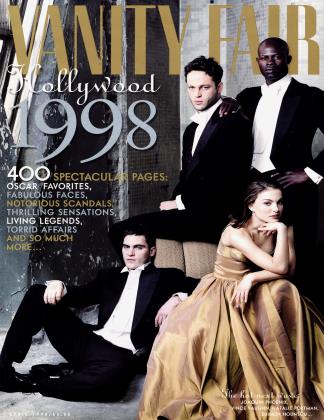 View Full Issue
View Full Issue





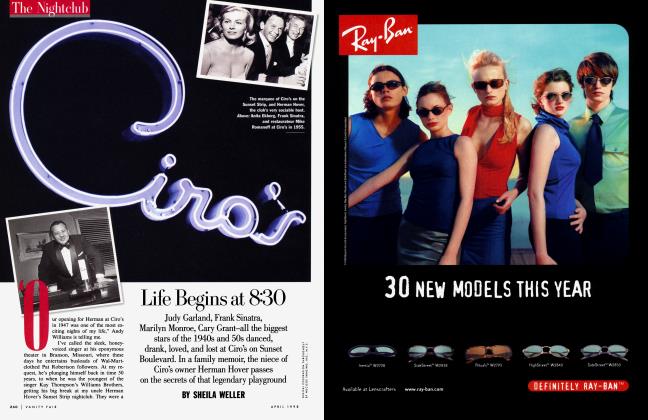
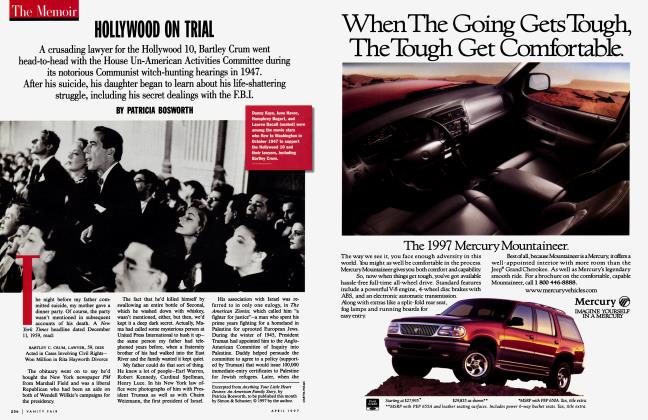





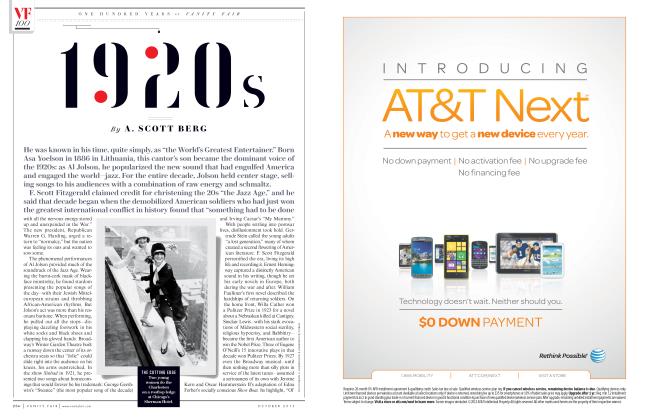




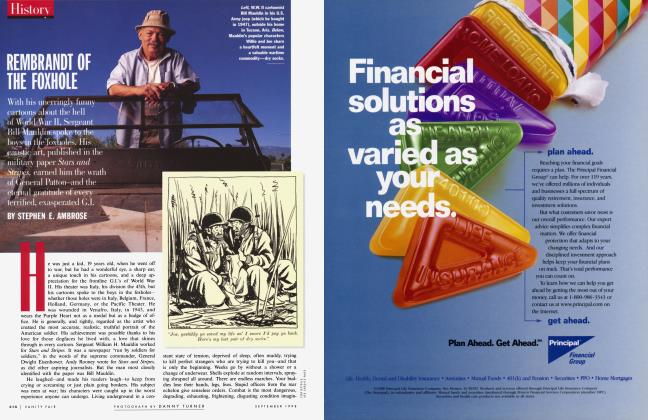
Subscribers have complete access to the archive.
Sign In Not a Subscriber?Join Now